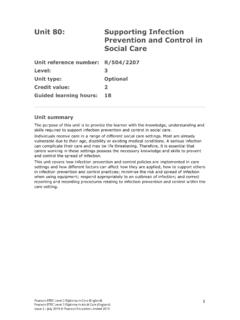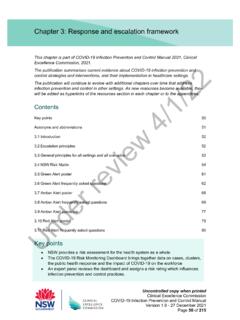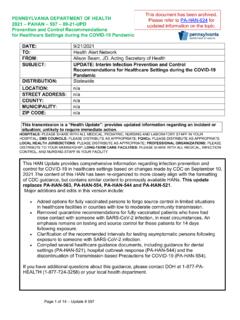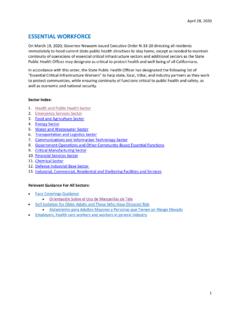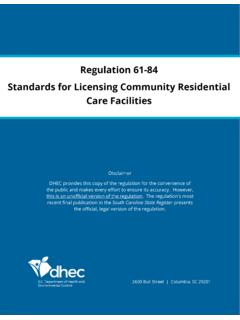Transcription of Latent TB Infection Testing and Treatment: Summary of …
1 Latent TB Infection Testing and treatment : Summary of RecommendationsEliminating tuberculosis (TB) in the United States requires expanding Testing and treatment of Latent TB centers for disease control and prevention (CDC) and the Preventive Services Task Force (USPSTF) recommend Testing people that are at increased risk for TB Infection . Clinicians, health care agencies, and community organizations, especially those serving populations at risk, have a critical role in TB elimination. JUNE 2020 SHOULD BE TESTED FOR TB Infection ?CDC and the USPSTF recommend Testing populations that are at increased risk for TB Infection . Anyone can get TB. However, some people have a higher risk of getting infected with TB bacteria.
2 CDC supports the USPSTF recommendation to test certain groups at risk for TB Infection . These groups include: People who were born in or who frequently travel to countries where TB disease is common, including Mexico, the Philippines, Vietnam, India, China, Haiti, Guatemala, or other countries with high rates of TB. (In general, people born in Canada, Australia, New Zealand, western European countries, or northern European countries are not considered at high risk for TB Infection unless they spent time in a country with a high rate of TB.) People who currently live or used to live in large group settings where TB is more common, such as homeless shelters, prisons, or jails. CDC also recommends Testing for TB Infection for other groups at risk.
3 These groups include: Health care workers and others who work in places with high risk for TB transmission, such as hospitals, homeless shelters, correctional facilities, nursing homes, and residential homes for those with HIV. Anyone who has spent time with a person who has infectious TB disease . Children, especially those under age 5, have a higher risk of developing TB disease once infected. Therefore, Testing for TB Infection in children is important if they are in one of the risk groups noted to the right. Some people with weaker immune systems, such as those with certain health conditions or who take certain medications, have a higher risk of developing TB disease once infected. Testing for TB Infection should be part of their regular medical care.
4 Health conditions that increase a person s risk of developing TB disease once infected include: HIV Infection Recent Infection with M. tuberculosis (within the last two years) History of untreated or inadequately treated TB disease Medical treatments that suppress the immune system (such as tumor necrosis factor-alpha [TNF] antagonists, corticosteroids, or drug therapy following organ transplants) Silicosis; chronic renal failure; leukemia; or cancer of the head, neck, or lung Diabetes mellitus A gastrectomy or jejunoileal bypass Low body weight (<90% of ideal body weight) Substance use (such as injection drug use)2 RECOMMENDED TESTS FOR TB Infection : Testing for TB Infection should be a routine and integral part of health care for patients with increased risk for TB.
5 Health care providers are encouraged to use newer TB blood tests to screen for TB Infection . There are two kinds of tests that are used to determine if a person has been infected with TB bacteria: the TB blood test and the TB skin Blood Tests (Interferon Gamma Release Assays [IGRAs]) TB blood tests (sometimes called IGRAs) use a blood sample to find TB Infection . The tests measure the response of TB proteins when they are mixed with a small amount of blood. Only one visit is required to draw blood for the blood tests are the preferred method of TB Testing for people 5 years of age and older who have received the bacille Calmette-Gu rin (BCG) Skin Test (TST) The TB skin test is also called the Mantoux tuberculin skin test (TST).
6 With a TB skin test, a health care provider injects a small amount of Testing fluid (called tuberculin or PPD) into the skin on the lower part of the 2-3 days, the skin test reaction must be examined by a trained health care worker. The health care worker measures any swelling where the tuberculin was injected to determine if the reaction to the test is positive or skin tests are an acceptable alternative in situations where a TB blood test is not available, is too costly, or is too burdensome. A positive reaction to a TB blood test (IGRA) or TB skin test (TST) usually means TB Infection . More tests, such as a chest x-ray, are needed to rule out TB disease . A diagnosis of Latent TB Infection is made if a person has a positive TB blood test (IGRA) or TST result and a medical exam does not indicate TB treatment REGIMENS FOR Latent TB Infection : Treating Latent TB Infection is effective in preventing TB disease and less costly than treating TB disease .
7 There are several treatment regimens for the treatment of Latent TB Infection . These regimens use the drugs isoniazid, rifapentine, or rifampin. CDC and the National Tuberculosis Controllers Association (NTCA) preferentially recommend short-course, rifamycin-based, 3- or 4-month Latent TB Infection treatment regimens over 6- or 9-month isoniazid monotherapy (6H or 9H, respectively). Short-course regimens include: Three months of once-weekly isoniazid plus rifapentine (3HP) Four months of daily rifampin (4R) Three months of daily isoniazid plus rifampin (3HR) Short-course Latent TB Infection treatments are effective, are safe, and have higher completion rates than longer treatments.
8 If a short-course treatment regimen is not an option, 6H or 9H is an effective alternative Latent TB Infection treatment regimens help patients finish treatment . All treatment must be modified if the patient is a contact of an individual with drug-resistant TB disease . Consultation with a TB expert is advised if the known source of TB Infection has drug-resistant TB. Clinicians should choose the appropriate treatment regimen based on drug susceptibility results of the presumed source case (if known), coexisting medical conditions ( , HIV Infection ), and potential for drug- drug interactions. Clinicians may choose to administer Latent TB Infection treatment through directly observed therapy (DOT) or self-administered therapy (SAT) based on local practice, individual patient attributes, and provider TB Infection ONLINE RESOURCE HUBCDC s One-stop Shop for Information, Guidance, and EducationThe Latent TB Infection Online Resource Hub is a collection of downloadable materials for informing and educating the public, health care providers, policy makers, and other partners about the importance of expanded Latent TB Infection Testing and treatment .
9 Available resources include: Guidance Documents Fact Sheets for Clinicians & Patients Communication Templates Key Messages & Social Media Content Slide Sets Images & Videos Infographics Helpful Links & More Follow @CDC_TB on Twitter Like @CDCTB on Facebook4










